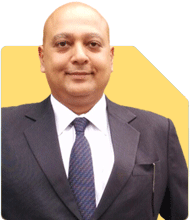Ramalingam Kalirajan |5983 Answers |Ask -Follow
Mutual Funds, Financial Planning Expert - Answered on Jul 15, 2024
He has an MBA in finance from the University of Madras and is a certified financial planner.
He is the director and chief financial planner at Holistic Investment, a Chennai-based firm that offers financial planning and wealth management advice.... more
.jpg)
Hello I am 28 year old my in hand salary is 40kpm I am married women currently no child. How I manage my expense and savings ? In which fund I invest for secure future.
Compliments and Understanding
You're already ahead by thinking about your financial future. Many don't plan at your age. It shows your foresight and responsibility. Your proactive approach is commendable and will surely pave the way for a secure financial future.
Creating a Budget
A budget is the cornerstone of financial planning. It helps track income and expenses, ensuring that you live within your means and save for future goals.
Step-by-Step Budgeting
Income: Your monthly take-home salary is Rs 40,000.
Essential Expenses: Include rent, groceries, utilities, transportation, and healthcare. Aim to keep these below 50% of your income, which would be Rs 20,000.
Discretionary Expenses: Allocate 30% of your income to dining out, entertainment, and personal shopping. This would be Rs 12,000.
Savings and Investments: The remaining 20%, or Rs 8,000, should go towards savings and investments.
Emergency Fund
An emergency fund is a financial safety net. It should cover 3-6 months' worth of essential expenses.
Building an Emergency Fund
Start by setting aside a portion of your savings each month until you reach this target. A liquid fund is ideal for this purpose due to its low risk and easy access.
Investment Strategy
Investing wisely is crucial for wealth creation. Given your profile, a mix of investment options can provide stability and growth.
Mutual Funds
Mutual funds are excellent for long-term wealth creation. They offer diversification, professional management, and flexibility.
Actively Managed Funds: These funds aim to outperform the market through expert selection of securities. They are ideal for those who seek higher returns and are comfortable with moderate risk.
SIP (Systematic Investment Plan)
SIPs allow you to invest a fixed amount regularly. It inculcates discipline and averages out the cost of investment over time, reducing the impact of market volatility.
Debt Funds
Debt funds are suitable for conservative investors. They invest in fixed-income securities and provide steady returns with lower risk.
Diversification
Diversification reduces risk by spreading investments across different asset classes. This ensures that poor performance in one area does not drastically impact your overall portfolio.
Insurance Planning
Insurance is crucial for financial security. It protects against unforeseen events and ensures that your family's needs are met in your absence.
Life Insurance
Opt for a term plan with adequate coverage. Term plans offer high coverage at low premiums and are ideal for income replacement.
Health Insurance
Healthcare costs are rising. A comprehensive health insurance policy covers medical expenses, ensuring that your savings are not depleted by medical emergencies.
Retirement Planning
Retirement planning is essential for financial independence in later years. Start early to benefit from the power of compounding.
NPS (National Pension System)
NPS is a government-backed pension scheme. It offers tax benefits and helps build a retirement corpus.
Mutual Funds for Retirement
Equity mutual funds are ideal for long-term growth. They have the potential to generate higher returns, aiding in building a substantial retirement corpus.
Tax Planning
Efficient tax planning increases disposable income. Utilize available deductions and exemptions to reduce tax liability.
Section 80C Investments
Investments under Section 80C of the Income Tax Act offer tax deductions. Options include PPF, EPF, and ELSS.
Health Insurance Premiums
Premiums paid for health insurance qualify for deductions under Section 80D. This reduces taxable income while ensuring health coverage.
Goal-Based Planning
Financial goals provide direction and motivation. Categorize them into short-term, medium-term, and long-term goals.
Short-Term Goals
These include building an emergency fund and saving for a vacation or a gadget. Allocate funds in liquid or short-term debt funds.
Medium-Term Goals
These could be saving for a car or a down payment on a house. Consider balanced funds or debt funds for these goals.
Long-Term Goals
Long-term goals include children's education, retirement, and wealth creation. Equity mutual funds and SIPs are suitable for these goals due to their potential for high returns over time.
Review and Rebalance
Regular review of your financial plan is crucial. It ensures that your investments align with your goals and risk tolerance.
Annual Review
Conduct an annual review of your financial plan. Assess your progress and make necessary adjustments.
Rebalancing
Rebalancing involves realigning the weightings of your portfolio. It helps maintain the desired level of risk and return.
Avoiding Common Pitfalls
Certain financial mistakes can derail your plans. Being aware of these can help you avoid them.
Overspending
Stick to your budget and avoid impulse purchases. This ensures that you live within your means and save for future goals.
Inadequate Insurance
Ensure you have adequate life and health insurance. This protects against financial hardships due to unforeseen events.
Ignoring Inflation
Inflation erodes the value of money over time. Ensure your investments generate returns that outpace inflation.
Investment Tips
Here are some additional tips to enhance your investment strategy.
Start Early
The earlier you start investing, the more time your money has to grow. This maximizes the benefits of compounding.
Stay Invested
Stay invested for the long term to ride out market volatility. Short-term market fluctuations should not deter you from your financial goals.
Seek Professional Advice
A certified financial planner can provide personalized advice. They can help you create a tailored financial plan that aligns with your goals and risk tolerance.
Final Insights
Your proactive approach towards financial planning is commendable. By creating a budget, building an emergency fund, investing wisely, and planning for insurance and retirement, you're on the right path. Regular reviews and avoiding common pitfalls will ensure that you stay on track.
Your financial journey is unique, and with careful planning and disciplined execution, you can achieve your financial goals. Remember, the key to financial success is consistency and patience.
Best Regards,
K. Ramalingam, MBA, CFP,
Chief Financial Planner,
www.holisticinvestment.in
You may like to see similar questions and answers below
Ramalingam Kalirajan |5983 Answers |Ask -Follow
Mutual Funds, Financial Planning Expert - Answered on May 15, 2024
Ramalingam Kalirajan |5983 Answers |Ask -Follow
Mutual Funds, Financial Planning Expert - Answered on Aug 21, 2024
Ramalingam Kalirajan |5983 Answers |Ask -Follow
Mutual Funds, Financial Planning Expert - Answered on Jun 25, 2024
Ramalingam Kalirajan |5983 Answers |Ask -Follow
Mutual Funds, Financial Planning Expert - Answered on Jun 23, 2024
Ramalingam Kalirajan |5983 Answers |Ask -Follow
Mutual Funds, Financial Planning Expert - Answered on Jul 17, 2024
Ramalingam Kalirajan |5983 Answers |Ask -Follow
Mutual Funds, Financial Planning Expert - Answered on Aug 22, 2024
Ramalingam Kalirajan |5983 Answers |Ask -Follow
Mutual Funds, Financial Planning Expert - Answered on Aug 22, 2024
Ramalingam Kalirajan |5983 Answers |Ask -Follow
Mutual Funds, Financial Planning Expert - Answered on Aug 22, 2024
Ramalingam Kalirajan |5983 Answers |Ask -Follow
Mutual Funds, Financial Planning Expert - Answered on Aug 22, 2024
Sushil Sukhwani |501 Answers |Ask -Follow
Study Abroad Expert - Answered on Aug 22, 2024
Ramalingam Kalirajan |5983 Answers |Ask -Follow
Mutual Funds, Financial Planning Expert - Answered on Aug 22, 2024
Ramalingam Kalirajan |5983 Answers |Ask -Follow
Mutual Funds, Financial Planning Expert - Answered on Aug 22, 2024
Ramalingam Kalirajan |5983 Answers |Ask -Follow
Mutual Funds, Financial Planning Expert - Answered on Aug 22, 2024
Ramalingam Kalirajan |5983 Answers |Ask -Follow
Mutual Funds, Financial Planning Expert - Answered on Aug 22, 2024
Ramalingam Kalirajan |5983 Answers |Ask -Follow
Mutual Funds, Financial Planning Expert - Answered on Aug 22, 2024























